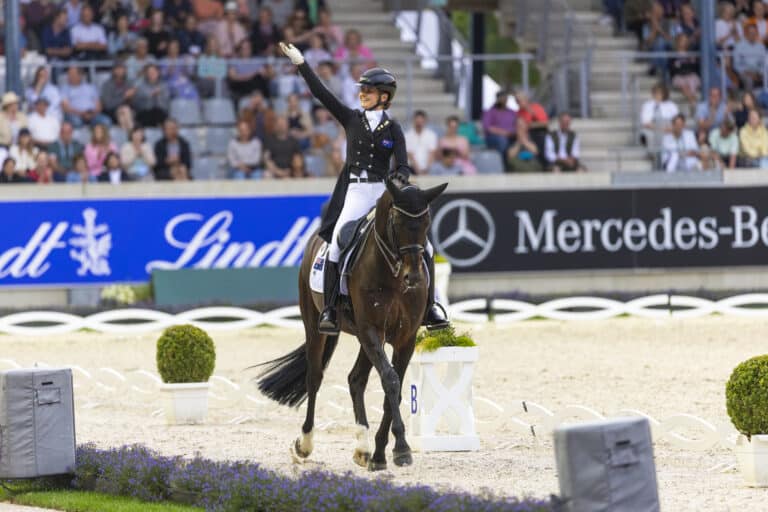Tori Stuckey and Mayfield Frizzante strut their stuff under the watchful eye of Carl Hester.
© Stephen Mowbray
By Kerry Mack
The second class at the Masterclass consisted of two young riders on Medium level horses. Alicia Ryan and the beautiful Bluefields Furstentanz, and Tori Stuckey, my daughter on her home bred Mayfield Frizzante. Frizzante is a 1.30 metre showjumper who also is doing dressage.
Carl got straight into the work with Alicia to improve the flying changes. The first change was late behind. Carl advised ‘don’t make a mistake a big deal, just correct it’.
‘Firstly make the canter quicker in the hind leg with transitions within the canter. Shorter steps, very uphill, on the spot. Ride him into the bridle, hands up. Try not to use the hands to shorten the canter. The horse must learn to balance in the shorter canter without the rein. He must develop self carriage in the collected canter’.
‘Don’t work to hard for it, he must do the work’.
He asked Alicia to straighten the canter by riding in counter canter along the wall, then making a little shoulder in in the counter canter. Left canter, counter canter, right shoulder in with only a small angle. This straightens him and gets him into the new outside rein. Play with the canter and make it shorter in the exercise. Make him quick with a little touch with the whip as you give the aid for the change. Use repetition of the exercise so he understands what is wanted. It is good if he anticipates because it shows he understands.

Alicia Ryan and the beautiful Bluefields Furstentanz work on their flying changes.
© Stephen Mowbray
The flying changes became correct, bigger and more uphill. This was great to watch how Carl went back to the foundations, systematically made the canter quicker and straighter, building on the quality patiently and with repetition, with his eye on the goal (quicker, cleaner changes). And the result was realised.

Alicia Ryan and Bluefields Furstentanz.
© Stephen Mowbray
This was the process in every lesson. Carl looked at what was happening, praised the strengths, identified the weakness and helped the rider correct the problem. This is work with integrity. Of course as a rider it is way more comfortable to show off the strengths in front of 2,500 people, rather than address the weaknesses – but Carl was not here just to make people look good. There was a sense that he really wanted to help each person improve.
Clean uphill changes accomplished, Carl turned his attention to Tori. Frizzante is very quick off the leg – too quick really. Her canter is excellent. Carl wanted her to develop more suspension in the trot. This is work to improve the trot. He had said in the earlier class that when choosing a potential dressage horse the quality of canter and walk were most important, because you can improve the trot. Now he was showing us how.

Tori Stuckey and Mayfield Frizzante.
© Stephen Mowbray
‘Ride shoulder in on a small circle, allow her to accept your leg. Correct your own leg position, the rider’s leg must be underneath them, a straight line from the shoulder, hip, heel. If in the shoulder in she goes wide behind (she doesn’t) send her forward and straight to correct it and put energy back in’.
‘Only a small angle so you don’t slow her down, inside rein in the neck, inside hand up, pat her with the inside hand. Don’t use your hands like handle bars.’ Here, Carl means don’t allow the outside hand forward when bending the horse.
‘Make the front legs slower to build carrying capacity. Disturb the horse. Be less tactful, be more manly (demanding), she has to let you in.’

Carl uses humour to cajole each rider to playfully follow his instructions. A sense of play infuses all the teaching.
‘Circle in the shoulder in and then ride forward. Now trot to canter transitions. Use the trot to improve the canter. She stretches the base of the neck in the transition and this helps her become more through in the back. Now in a light seat at canter, do the shoulder in. Canter-to-trot transitions in shoulder in. Go everywhere in shoulder in. Shoulder in for breakfast!’.
‘Now a dribbly trot, let the neck out, stretch’. Carl wants to see each horse stretch at the end, reaching into the bridle, seeking a contact.
‘What are the basics?’ Carl asks. He answers: ‘straightness, contact, transitions, rhythm’. Always improve the basics.
Certainly there was plenty to take away and practise in this lesson.
READ THE LATEST NEWS ARTICLES HERE







